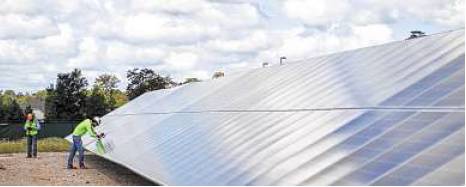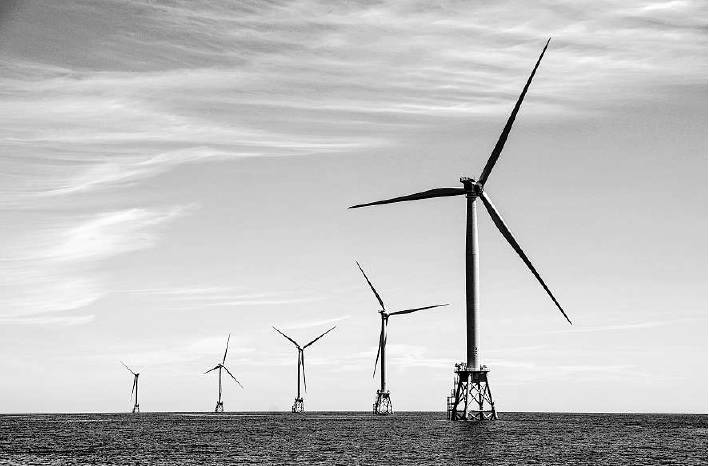Renewables face future without subsidies
Outlook mixed on how wind, solar projects will fare in Texas as federal tax credits wane
By James Osborne STAFF WRITER
WASHINGTON — More than 25 years after Congress created tax credits to encourage the development of renewable energy, wind turbines and solar panels will soon have to fend for themselves as they never have before.
Under the spending deal approved shortly before Congress took its holiday break, the investment tax credit, which reimburses 30 percent of the cost of new solar systems, will begin winding down next month, dropping to 10 percent for most companies by 2022. The energy production tax credit, which gives wind power generators roughly 2 cent per kilowatt boost, will follow in 2021, decreasing steadily until eventually hitting zero in 2025.
In the short term, analysts forecast that both technologies will see surges in installations, as residents and developers seek to take advantage of the tax credits while they can. In 2017, wind and solar developers received $11.6 billion in credits, according to the independent Congressional Research Service.
But once the credits hit their designated ends, that growth is expected to slow. The research firm IHS Markit is forecasting wind development will peak next year at 14 gigawatts of new turbines, not to reach those heights again at least through 2050. The outlook for solar installations is less certain.
Solar installations are expected to grow quickly through 2023 and then gradually decline. IHS Mar-kit predicts that solar will expand its generation capacity by 10 gigawatts in 2030 — down 10 percent from the roughly 11 gigawatts of solar generation installed in 2019. A gigawatt can power about 700,000 homes.
But Camron Barati, an analyst at IHS Markit, said that forecast might be too pessimistic. The cost of solar panels continues to fall and the efficiency of the materials that convert sunlight into electricity is only increasing.
“We generally expect to be revising the long-term outlook upwards,” Barati said. “Through the remainder of the decade the cost competitiveness of (solar) technology is becoming quite compelling even without atax incentive.”
Federal tax credits helped Texas become — by far — the U.S. leader in wind energy. The state, which has about 27 gigawatts of installed wind capacity, accounts for more than one-fourth of the electricity generated by wind in the United States.
Solar, still a small player in Texas’ energy mix, is growing rapidly. The Electric Reliability Council of Texas, the state’s power grid manager, projects that installed solar-generating capacity will nearly quadruple to about 11 gigawatts in 2021 from 3 gigawatts at the end of this year.
After years of supersonic growth — wind and solar accounted for more than 60 percent of new generation on the U.S. power grid this year — the end of the tax credits could well mark the beginning of a sobering period for wind and solar developers. Of the approximately $18 billion the federal government spends on energy subsidies each year, more than 60 percent goes to renewable energy.
Without that cash infusion, the wind and solar industries will need to become even more efficient, competing with energy sources such as natural gas and nuclear that will continue to receive federal subsidies. Under federal tax law, oil and natural gas drillers are singled out for lucrative deductions based on the amount of energy they produce. And nuclear power plants receive a long list of federal benefits, including a $500 million cap on liability in the event of a meltdown.
The task is especially tall for wind energy, which is a “more mature technology” than solar, said Max Cohen, another analyst at IHS Markit. Unable to build bigger turbines to increase efficiency — at least with current technology — engineers are developing wind farms where advanced software adjusts the angles of individual turbines to improve the flow of wind across the entire farm.
In Texas, scientists are working on developing a next generation wind turbine that is larger and lighter than existing equipment, but also more fragile. To avoid a costly break they install electronic devices along the blades to reduce the velocity of the air flow across the turbines’ delicate blades.
“The name of the game is to make them bigger without increasing cost, so we need more intelligent turbines,” said Mario Rotea, a mechanical engineering professor at the University of Texas-Dallas. “Everyone is looking for more annual energy production, lower capital costs. It’s an area ripe for innovation.”
In the meantime, the renewable energy industry is not giving up on continued government support. Many states are setting ambitious goals to increase the wind, solar and other clean energy technologies in their power mix. New York, Massachusetts and New Jersey, for example, have planned a series of offshore wind projects, in hopes of jump starting the industry there, despite the initial high cost.
Federal tax credits could make a comeback, too. While Democrats might have failed in their bid to expand support for clean energy technologies, the situation could well change after next year’s election.
John Berger, CEO of the Houston firm Sunnova, which installs and services residential solar and battery systems, said he expects Congress eventually to revive the tax credits. Even if that doesn’t happen, he said, the industry was anticipating that Congress would roll back subsidies and will adjust and continue to grow.
“This is not a surprise, just a disappointment,” Berger said. “We’re going to be fine.” james.osborne@chron.com twitter.com/osborneja

